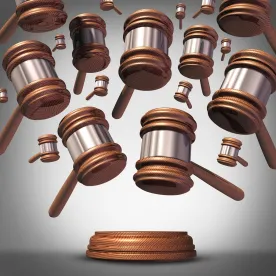When the PTAB renders a decision, one of the parties is almost certain to be unhappy. Providing appropriate advice in the face of an undesired outcome requires an understanding of the odds of changing the outcome. This article briefly reviews the success rates of requests for rehearing in PTAB proceedings to provide better context for considering whether and when a request for rehearing may be advisable.
The graph below shows the outcomes from all requests for rehearing (i.e., requests for rehearing institution decisions and final written decision) that have been filed with the PTAB from 2013 to date.
It’s easy to look at these numbers and be discouraged, as the denial rate has consistently remained around 90% or higher. But if the requests are broken down further into those involving institution decisions and those involving final written decisions, some more nuanced trends can be seen.
While requests for rehearing face long odds regardless, the overall success rate of requests for rehearing of final written decisions show somewhat higher success rates compared to those of institution decisions. As shown in the graph below, in 2017 and 2018 requests for rehearing final written decisions were granted 10.4% and 7.7% of the time, respectively. If partial grants (i.e., those requests that were granted-in-part and denied-in-part) are taken into account as well, these numbers jump to 11.9% and 13.4%. Of course, this still means that almost 90% of the requests were denied, but these success rates are nevertheless a significant improvement over the 2.5% and 6.4% success rates seen for requests for rehearing of institution decisions during 2017 and 2018.
The slightly higher success rate of requests for rehearing of final written decisions makes some logical sense. The purpose of rehearing is to “identify all matters the party believes the Board misapprehended or overlooked, and the place where each matter was previously addressed in a motion, an opposition, or a reply” (37 C.F.R. § 42.71), and there’s simply more matter that the Board could have “misapprehended or overlooked” when it is working with a complete record rather than just a petition and preliminary response. Of course, the comparatively higher grant rates of requests for rehearing of final written decisions in 2017 and 2018 have not held for 2019 thus far, so we may be in the midst of a down trend. Given the meager grant rates overall, practitioners should consider whether requesting rehearing is worth the time, effort, and expense after receiving a negative initial or final written decision.
Curiously, despite the somewhat worse chances of success, requests for rehearing of institution decisions outnumber those after a final written decision by nearly 3 to 1 (specifically 1,184 to 322). This may be because final written decisions are more easily appealable to the Federal Circuit (absent standing issues), while unfavorable institution decisions are not directly appealable, which means petitioners are left without an alternative to requesting rehearing and patent owners must wait until a final written decision has issued before they have a chance to appeal. Thus, given the stakes of the institution decision, particularly for petitioners, it is not altogether surprising that over the last three years approximately 80% of requests for rehearing of institution decisions were filed by petitioners, as shown in the graph below.
The converse of this trend is seen after final written decisions, where patent owners have consistently requested rehearing more often than petitioners, as shown in the graph below.
With this disparity between the parties’ preference for filing after institution (petitioner) versus after final written decision (patent owner) in mind, we have also studied historical rehearing decisions to determine whether there was a noticeable difference in outcomes depending on which party was seeking the rehearing. However, with respect to requests for rehearing, the PTAB appears to be fairly uniform with its treatment of petitioners and patent owners. A review of the last 3 years’ worth of rehearing decisions reveals no major difference in outcome regardless of whether a patent owner or petitioner was requesting rehearing. While petitioners were somewhat more successful than patent owners in 2018, patent owners saw a greater number of granted requests in 2017, and there has been no significant difference thus far in 2019.
In sum, while requesting rehearing at the PTAB is an option for challenging a negative decision, it is an option that should be carefully weighed because the odds of success are quite low. Although the odds of having a request granted after a final written decision may be somewhat higher compared to requests for rehearing of the institution decision, the limited availability of an alternative recourse after institution will likely continue to make this the most popular event for triggering a request for rehearing.
Authors’ note: Jason Mock and Mike Houston would like to thank Patrick Nyman, a 2019 Summer Associate at Foley & Lardner LLP, for compiling some of the initial data used in the preparation of this article.





 />i
/>i







